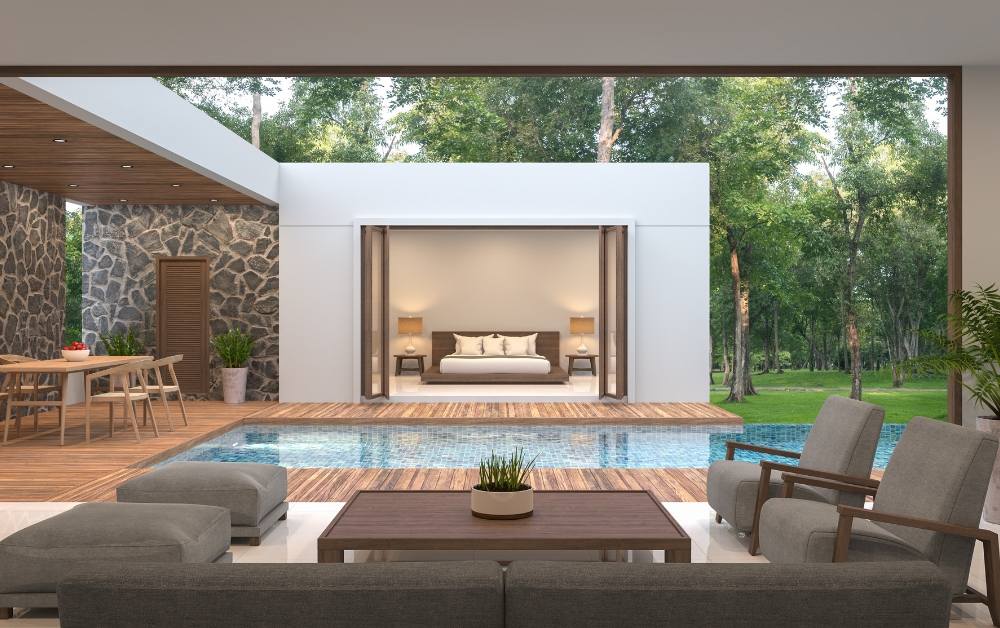Why Landscape Architecture Renderings Pay Off
Posted by admin
Landscape rendering is a fascinating blend of art and technology that brings the beauty of nature to life on canvas. It acts as a captivating bridge, connecting the tangible wonders of the natural world with the limitless creativity of human expression. With a delicate balance of artistic sensibility and technical expertise, landscape rendering transforms blank canvases into vibrant scenes that transport viewers to mesmerizing realms of serenity and awe.
This professional process involves the creation of realistic and visually captivating depictions of outdoor spaces, encompassing everything from gardens and parks to commercial complexes and residential developments.
3D Landscape rendering plays a pivotal role in conveying the intricate interplay of natural elements, architectural elements, and human interactions within a built environment. Its application allows architects, designers, and stakeholders to collaboratively explore various design options, refine concepts, and bring forth landscapes that complement the built structures.
This article will explore the numerous benefits of landscape architecture renderings. Learn why investing in them pays off for professionals in the field.
Table of Contents
What are the components of Landscape Rendering?
Landscape rendering involves creating visual representations of outdoor environments. The process typically includes several components to achieve a realistic and visually appealing result. These components are:
Check Here: 3d Rendering Services
Terrain Modeling: The first step is to create a 3D representation of the landscape’s terrain. This involves using various techniques such as heightmaps, procedural generation, or manual sculpting to simulate the hills, valleys, mountains, rivers, and other natural features of the landscape.
Vegetation: Adding vegetation like trees, bushes, grass, and plants is essential to creating a believable landscape. There are different methods to incorporate vegetation, including using 3D models, instancing techniques, or employing advanced procedural methods.
Textures and Materials: Applying high-quality textures and materials to the terrain and objects in the scene is crucial for realism. Textures help define the surface appearance of various elements, such as grass, rocks, sand, water, etc.
Lighting: Proper lighting is essential to set the mood and atmosphere of the landscape. The position of the sun or other light sources, as well as the choice of lighting model, greatly impact how the scene looks and feels.
Art Installations and Sculptures: Artistic elements in the form of sculptures or installations add a unique character and creative expression to the landscape rendering.
Pavements and Pavers: Various types of pavements and pavers are used to create visually appealing patterns, delineate spaces, and provide a stable surface for foot traffic.
Shading and Rendering: Shading involves calculating how light interacts with the objects and surfaces in the scene. Techniques such as ray tracing, rasterization, or hybrid methods are used to render the final image with accurate shadows, reflections, and other lighting effects.
Atmosphere and Weather Effects: Introducing atmospheric effects like fog, haze, or rain can add depth and realism to the landscape. Weather effects such as clouds and storms can also significantly enhance the visual impact.
Water Bodies: Rendering water bodies, such as lakes, rivers, or oceans, requires special attention to simulate their reflective and refractive properties, as well as water movement and animation.
Outdoor Furniture: Benches, tables, seating areas, and other outdoor furniture pieces offer comfort and functionality, encouraging people to spend time outdoors and interact with the environment.
Camera and Composition: Choosing the right camera angle and composition can greatly influence the final image’s aesthetics. Camera settings like focal length, depth of field, and composition rules (e.g., rule of thirds) are considered during this stage.
Post-Processing: After the initial rendering, post-processing effects like color correction, bloom, motion blur, and vignettes may be applied to enhance the overall visual quality of the image.
Optimization: Finally, optimization is performed to balance visual quality and performance. This ensures that the landscape can be rendered efficiently in real-time applications or large-scale environments.
Enhancing Communication and Understanding
Landscape renderings hold immense significance within the realm of architecture, serving as a pivotal tool that enables architects and clients to envision and grasp the aesthetics of an outdoor space before its actual implementation. This process involves the creation of lifelike and intricate portrayals of landscapes, granting a sneak peek into what the future holds.
In essence, it acts as a bridge between the imagination of architects and the understanding of clients, facilitating seamless communication of design ideas and empowering informed decision-making. For example, users can envision the future growth of their planted plants, trees, and shrubs. By utilizing 3D landscape rendering, they can check how these green plants will grow over time, gaining insights into the landscape’s long-term aesthetics and ensuring a well-planned, thriving outdoor space.
These visual representations bridge the gap between technical jargon and layman’s language. This makes it easier for clients to comprehend complex design concepts. As a result, clients are more likely to provide valuable feedback and discussions. This landscape design rendering leads to improved collaboration throughout the design process.
Gain more clients with landscape architecture renderings
Landscape architecture renderings act as a persuasive sales tool. A well-crafted rendering can evoke emotions when presenting design concepts to potential clients. It creates a sense of excitement about the project’s potential.
The importance of landscape rendering cannot be overstated, as it empowers architects to convey their creative concepts with clarity and precision. When architects present their visions through compelling and realistic visualizations, it becomes easier for clients to comprehend the proposed design’s overall feel and appearance. This enhances the collaborative aspect of the design process, as clients can provide valuable feedback and preferences based on a concrete depiction of the project.
By showcasing the functionality, these renderings can turn sceptics into advocates. It increases the likelihood of securing contracts and funding.
Minimizing Misinterpretations
2D drawings can lead to costly errors during construction due to misinterpretation. 3D landscape rendering techniques leave little room for confusion. Through the magic of landscape rendering, various essential elements of the design can be effectively showcased. These include the placement of buildings, walkways, green spaces, water features, lighting, and other crucial aspects that define the outdoor area’s ambience.
Not only does this aid in refining the design and ensuring it aligns with the client’s aspirations, but it also helps to identify potential challenges or improvements early in the planning stage. When clients can see in advance how the lights will look, or the height of trees in future it helps in minimizing misinterpretations.
Stakeholders can view the project from different angles. They can understand the interplay of various design elements. This heightened clarity reduces the risk of miscommunication. It ensures everyone shares a common vision for the final landscape.
Showcasing Design Creativity
Standing out from the crowd is essential in the competitive landscape architecture industry. High-quality rendering landscape plans allow designers to showcase their creativity and innovative thinking in plantation, soft landscape or hard landscape.
With photorealistic representations, professionals can:
- Present unique design solutions
- Demonstrate the integration of sustainable practices.
- Exhibit their ability to transform spaces into stunning and functional environments.
- Exploring Design Iterations
Landscape renderings enable architects to explore multiple design iterations during the design phase. By creating various renderings, designers can compare and assess their visual impact. This iterative process helps refine the design, producing a more polished final plan.
Gaining Regulatory Approval
Landscape architecture projects often need to navigate through regulatory approvals and community feedback. 3d landscape rendering can be instrumental in these processes. A visually appealing rendering can help convey the project’s benefits to regulators. It makes it easier to gain necessary approvals and support.
Marketing and Promotion
Landscape architecture renderings serve as influential marketing assets that empower architects and designers in various ways. By presenting captivating and true-to-life depictions of their projects, these professionals can effectively captivate potential clients, secure new projects, and establish a distinct identity amidst competition. Moreover, renderings play a crucial role in facilitating successful presentations to various stakeholders, investors, and planning authorities, who often demand a comprehensive understanding of the proposed design before granting approvals or funding.
Moreover, landscape renderings allow architects and designers to express their artistic flair and unique style, enabling them to stand out from the crowd. Each rendering can be tailored to reflect the specific aesthetic, theme, or ambiance of a project, creating a strong brand identity that resonates with clients and sets the professional apart from competitors.
Cost and Time Savings
Investing in detailed landscape renderings saves costs and time in the long run. Identifying design issues early through visualization can cut costly design revisions. The investment in landscape renderings pays off as an efficient construction process.
During the initial phase, landscape renderings allow professionals to assess various elements in a 3D environment. This immersive approach helps foresee any conflicts or inconsistencies during construction. By addressing these concerns landscape architects can avoid expensive modifications.
Furthermore, the accuracy of rendering landscape plans ensures that the final project aligns with the client’s vision. This reduces the likelihood of costly change orders, saving both time and money.
Conclusion
In conclusion, landscape renderings are essential tools for architects and designers, contributing significantly to their marketing efforts and professional success. By leveraging the visual impact of renderings, professionals can attract clients, secure projects, and differentiate themselves in a competitive industry.
Landscape architecture renderings are more than pretty pictures. They enhance communication, promote creativity, and facilitate decision-making. Professionals can elevate their designs and reduce costs by investing in landscape renderings. As the landscape architecture industry evolves, these visualization techniques will keep shaping the world around us.


